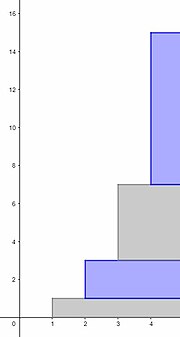In mathematics, 1 + 2 + 4 + 8 + ⋯ is the infinite series whose terms are the successive powers of two. As a geometric series, it is characterized by its first term, 1, and its common ratio, 2. As a series of real numbers it diverges to infinity, so the sum of this series is infinity.

However, it can be manipulated to yield a number of mathematically interesting results. For example, many summation methods are used in mathematics to assign numerical values even to a divergent series. For example, the Ramanujan summation of this series is −1, which is the limit of the series using the 2-adic metric.
Summation
editThe partial sums of are since these diverge to infinity, so does the series.
It is written as
Therefore, any totally regular summation method gives a sum of infinity, including the Cesàro sum and Abel sum.[1] On the other hand, there is at least one generally useful method that sums to the finite value of −1. The associated power series has a radius of convergence around 0 of only so it does not converge at Nonetheless, the so-defined function has a unique analytic continuation to the complex plane with the point deleted, and it is given by the same rule Since the original series is said to be summable (E) to −1, and −1 is the (E) sum of the series. (The notation is due to G. H. Hardy in reference to Leonhard Euler's approach to divergent series.)[2]
An almost identical approach (the one taken by Euler himself) is to consider the power series whose coefficients are all 1, that is, and plugging in These two series are related by the substitution
The fact that (E) summation assigns a finite value to shows that the general method is not totally regular. On the other hand, it possesses some other desirable qualities for a summation method, including stability and linearity. These latter two axioms actually force the sum to be −1, since they make the following manipulation valid:
In a useful sense, is a root of the equation (For example, is one of the two fixed points of the Möbius transformation on the Riemann sphere). If some summation method is known to return an ordinary number for ; that is, not then it is easily determined. In this case may be subtracted from both sides of the equation, yielding so [3]
The above manipulation might be called on to produce −1 outside the context of a sufficiently powerful summation procedure. For the most well-known and straightforward sum concepts, including the fundamental convergent one, it is absurd that a series of positive terms could have a negative value. A similar phenomenon occurs with the divergent geometric series (Grandi's series), where a series of integers appears to have the non-integer sum These examples illustrate the potential danger in applying similar arguments to the series implied by such recurring decimals as and most notably . The arguments are ultimately justified for these convergent series, implying that and but the underlying proofs demand careful thinking about the interpretation of endless sums.[4]
It is also possible to view this series as convergent in a number system different from the real numbers, namely, the 2-adic numbers. As a series of 2-adic numbers this series converges to the same sum, −1, as was derived above by analytic continuation.[5]
See also
edit- 1 − 1 + 2 − 6 + 24 − 120 + ⋯
- 1 − 1 + 1 − 1 + ⋯ (Grandi's series)
- 1 + 1 + 1 + 1 + ⋯
- 1 − 2 + 3 − 4 + ⋯
- 1 + 2 + 3 + 4 + ⋯
- 1 − 2 + 4 − 8 + ⋯
- Two's complement, a data convention for representing negative numbers where −1 is represented as if it were 1 + 2 + 4 + ⋯ + 2n−1.
Notes
edit- ^ Hardy p. 10
- ^ Hardy pp. 8, 10
- ^ The two roots of are briefly touched on by Hardy p. 19.
- ^ Gardiner pp. 93–99; the argument on p. 95 for is slightly different but has the same spirit.
- ^ Koblitz, Neal (1984). p-adic Numbers, p-adic Analysis, and Zeta-Functions. Graduate Texts in Mathematics, vol. 58. Springer-Verlag. pp. chapter I, exercise 16, p. 20. ISBN 0-387-96017-1.
References
edit- Euler, Leonhard (1760). "De seriebus divergentibus". Novi Commentarii Academiae Scientiarum Petropolitanae. 5: 205–237.
- Gardiner, A. (2002) [1982]. Understanding infinity: the mathematics of infinite processes (Dover ed.). Dover. ISBN 0-486-42538-X.
- Hardy, G. H. (1949). Divergent Series. Clarendon Press. LCC QA295 .H29 1967.
Further reading
edit- Barbeau, E. J.; Leah, P. J. (May 1976). "Euler's 1760 paper on divergent series". Historia Mathematica. 3 (2): 141–160. doi:10.1016/0315-0860(76)90030-6.
- Ferraro, Giovanni (2002). "Convergence and Formal Manipulation of Series from the Origins of Calculus to About 1730". Annals of Science. 59 (2): 179–199. doi:10.1080/00033790010028179. S2CID 143992318.
- Kline, Morris (November 1983). "Euler and Infinite Series". Mathematics Magazine. 56 (5): 307–314. doi:10.2307/2690371. JSTOR 2690371.
- Sandifer, Ed (June 2006). "Divergent series" (PDF). How Euler Did It. MAA Online. Archived from the original (PDF) on 2013-03-20. Retrieved 2007-02-17.
- Sierpińska, Anna (November 1987). "Humanities students and epistemological obstacles related to limits". Educational Studies in Mathematics. 18 (4): 371–396. doi:10.1007/BF00240986. JSTOR 3482354. S2CID 144880659.